Summary (English)
In June 2006, the Archaeological Museum of Istria carried out a rescue excavation of a small Roman-period complex for economic activities, which belongs to the latifundia of the wider coastal area of Fažana. It is located on the first kilometre of the main gas pipeline route Pula – Karlovac, east of the Pula – Fažana road. The small villa is located between the settlement of Mala Vala and a few hundred meters south of Šurida, where the Roman period settlement remains were discovered in 1981. The villa is surrounded by the preserved parts of the Roman centuriation between today’s settlement of Šurida and Runci Bay, which could have been the commercial port of the rural villa in the neighbouring Valbandon Bay.
The rectangular rural villa measures 18.5 × 13 m. Inside the building, the smaller part of space is divided by original walls, while the larger by subsequently constructed walls containing spolia, and in places by drystone walls. Several discarded parts of columns and fragments of containers made of limestone or marble were found at the site. Fragments of a mill (mola olearia) indicate that, at least in the initial phase, the building served as an oil mill, and later perhaps as a wine production facility.
In the western part of the villa, a cistern lined with hydraulic plaster has been preserved, probably a lacus with a built-in stone recess for cleaning the sediment (amurca). The other rooms of this small facility were offices especially for carpentry work on maintenance and repair of wooden parts of the torcularium, as confirmed by the iron carpentry chisel. The only Roman bronze coin found is illegible.
In addition to characteristic building ceramics, some amphorae fragments, several fragments of Late Antique vessels with a coarse texture and wavey decorative lines, early Christian oil lamps, ceramic spoons, and spindle whorls were collected. Among the characteristic building ceramics, two tegulae with workshop stamps were found. They belong among the four most represented in the sites of Roman period Istria: A(eli) or A(uli) F[aesoni Af(ricani)] and [...Pa]nsiana, which belongs to the workshop that seems to have been located in the area of the Po delta, north of Ravenna, and active from the middle of the 1st century BC to Vespasian. Interesting finds are two knives and a kidney-shaped flint fire starter, which are reminiscent of typical items from early medieval Slavic graves (7th and 8th centuries) in northern Istria (Željko Ujčić 2007, Hrvatski arheološki godišnjak 3/2006, 273–275).
- Željko Ujčić
Director
- Željko Ujčić
Team
- Aleksandra Pajić
- Ivo Juričić
Research Body
- Arheološki muzej Istre
Funding Body
- INA – industrija nafte d.d., SD Naftaplin






![Download [PDF]](/excavation/skins/fasti/images/results/download_sml.png)

